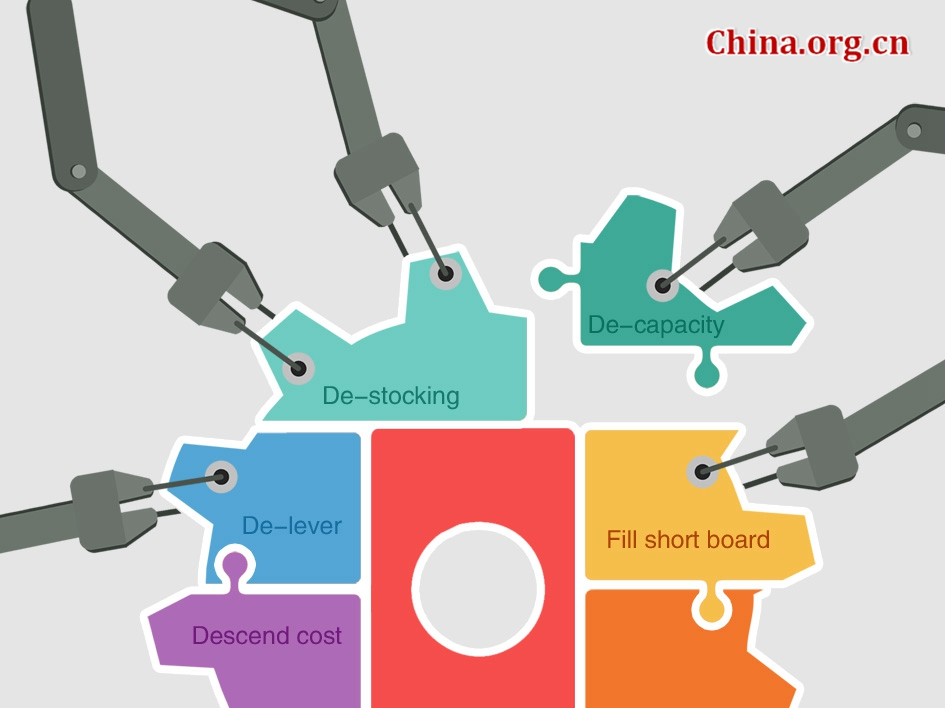China pushes ahead with SOE reform
 0 Comment(s)
0 Comment(s) Print
Print E-mail China.org.cn, May 31, 2016
E-mail China.org.cn, May 31, 2016
With the economy slowing, China has been looking to its 150,000 state-owned enterprises (SOEs) to promote market-based reform, which remains a tough nut to crack.
 |
|
Supply-side reform |
On May 16 at a meeting of the Central Leading Group for Financial and Economic Affairs, General Secretary Xi Jinping of the Central Committee of the Communist Party of China (CPC) called for "unswerving efforts" to advance supply-side structural reform, reiterating that the reform of SOEs is a very important part of this.
On May 18, Chinese Premier Li Keqiang presided over an executive meeting of the State Council, emphasizing that centrally-administered SOEs should streamline their corporate structures and raise efficiency to become more competitive.
On May 20, Xi chaired a meeting of the Central Leading Group for Deepening Overall Reform and once again called for the reform of SOEs, urging departments to identify problems and come up with effective approaches to them.
"Reform will cause pain, but without reform, the pain will last longer," reads a statement released after the meeting.
State-owned enterprises (SOEs), especially those administered by the central government, play a pivotal role in the country's social and economic development. However, plagued by low efficiency, they are not performing as well as they should be.
The centrally-administered SOEs made 339.88 billion yuan (US$51.87 billion) in profits during the first three months of this year, down 13.2 percent from the same period last year, according to statistics from the Ministry of Finance.
Cutting excess industrial capacity
To implement supply-side structural reform in SOEs, a major necessity is cutting excess industrial capacity, Xi stressed at the meetings.
Li also reiterated that the centrally-administered SOEs need to "lose weight and get fit," vowing to cut their coal and steel capacity by 10 percent this year, followed by another 10 percent in 2017.
The government will also press ahead with the merging and revamping of SOEs over the next three years in order to clean up 345 zombie enterprises – all subsidiaries of the 106 centrally-administered SOEs – and unlock their vitality, said Zhang Xiwu, deputy chief of the State-owned Assets Supervision and Administration Commission, at a briefing on SOE reform.
Zombie enterprises are unprofitable SOEs burdened by debt, mismanagement or overcapacity.
The Ministry of Finance also announced that China will allocate 100 billion yuan (US$15.3 billion) of subsidies to steel and coal companies; the funds will mainly be used to resettle laid-off workers.
The ministry added that it will continue to implement preferential taxation policies, including tax refunds for steel exports and tax preferences for urban land use by coal miners.
Upgrading industries through innovation
The statement from the May 18 meeting pledges to reduce losses made by centrally-administered SOE's subsidiaries by 30 percent and increase the profit of centrally-administered SOEs by more than 100 billion yuan (US$15.3 billion) by the end of 2017.
It also encourages SOEs to grow stronger through innovation and invest more in research and development.
Specifically, they should upgrade their enterprises and strengthen competitiveness by integrating the "Internet Plus" initiative with the big data development strategy. Manufacturing is the main focus.
By 2018, 80 percent of manufacturing companies should build online platforms. By 2025, online infrastructure should be used throughout the industry to raise competitiveness, the statement says.
The government also promises supportive policies in financing, taxation, land and human resources to develop internet-based manufacturing.
Last year, China unveiled the "Made in China 2025" blueprint, which aims to improve manufacturing and shift the country away from low-end manufacturing to more value-added production.
The "Internet Plus" initiative was also proposed last year to enable more businesses to take advantage of the internet.
Focusing on core businesses
"Fostering greater craftsmanship is of vital importance to centrally-administered SOEs. They should concentrate on their core business so as to improve product quality. This should be the core competence of the SOEs," Premier Li said during the May 18 meeting.
The statement released after the meeting encourages internal restructuring of centrally-administered SOEs and optimizing of their resource allocation in the next two years.
Private investors are encouraged to participate in and support the restructuring of the centrally-administered SOEs. Reform efforts concerning business registration procedures are to be intensified so as to reduce administrative costs.
Zhang Chunxiao, a researcher at the Chinese Academy of Governance, said that all the measures were part of supply-side reform.
"Centrally-administered SOEs can only boost profits when they focus on core businesses with lower managerial and production costs."
Streamlining corporate structure
“If the president cannot tell how many subsidiaries his or her company has, how can the company be efficient or competitive?” Premier Li questioned while presiding over the May 18 meeting.
The fact is that excessive layers of hierarchy and redundancy that have persisted in the centrally-administered SOEs are part of the reason why it hasn’t been easy to push through reform over the years.
To help the centrally-administered SOEs “lose weight and get fit,” the meeting decided that these enterprises should reduce their managerial levels to three or four from the current five to nine, while cutting 20 percent of their subsidiary legal entities within three years.
They were also instructed to use market-based approaches in hiring and delivering payrolls.
SOE reform is an urgent task for supply-side structural reform. It will be difficult to achieve results without transforming SOEs into real market entities in terms of technology and efficiency, said Li Yining, a Peking University economist.
Li Daokui, an economic adviser and a Tsinghua University economics professor, noted that this is the key year for national restructuring, and if all SOE and urbanization reforms are put in place this year, the economy's downward trend is expected to hit bottom by the second half of the year at the earliest.






Go to Forum >>0 Comment(s)